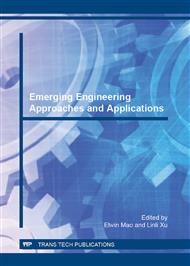[1]
Iris F.A. Vis. A comparative analysis of storage and retrieval equipment at a container terminal. Int. J. Production Economics, 2006, 103 : 680–693.
DOI: 10.1016/j.ijpe.2006.01.002
Google Scholar
[2]
Mohammad Bazzazi, Nima Safaei, Nikbakhsh Javadian. A genetic algorithm to solve the storage space allocation problem in a container terminal. Computers & Industrial Engineering, (2008).
DOI: 10.1016/j.cie.2008.03.012
Google Scholar
[3]
Chuqian Zhang, Jiyin Liu, Yat-wah Wan. Storage space allocation in container terminals. Transportation Research, 2003, Part B 37: 883–903.
DOI: 10.1016/s0191-2615(02)00089-9
Google Scholar
[4]
W.C. Ng, K.L. Mak. Yard crane scheduling in port container terminals. Applied Mathematical Modelling, 2005, 29: 263–276.
DOI: 10.1016/j.apm.2004.09.009
Google Scholar
[5]
Kap Hwan Kima, Keung Mo Lee, Hark Hwang. Sequencing delivery and receiving operations for yard cranes in port container terminals. Int. J. Production Economics, 2003, 84: 283–292.
DOI: 10.1016/s0925-5273(02)00466-8
Google Scholar
[6]
Der-Horng Lee, Zhi Cao, Qiang Meng. Scheduling of two-transtainer systems for loading outbound containers in port container terminals with simulated annealing algorithm. Int. J. Production Economics, 2007, 107: 115–124.
DOI: 10.1016/j.ijpe.2006.08.003
Google Scholar
[7]
Ebru K. Bish. A multiple-crane-constrained scheduling problem in a container terminal. European Journal of Operational Research, 2003, 144: 83–107.
DOI: 10.1016/s0377-2217(01)00382-4
Google Scholar


